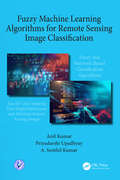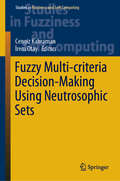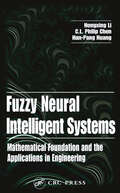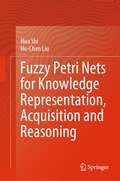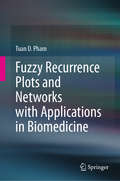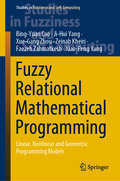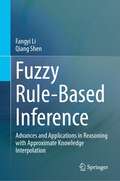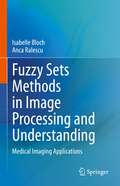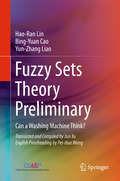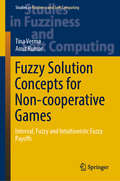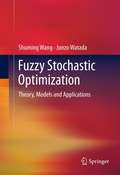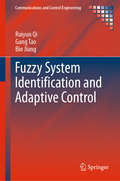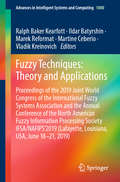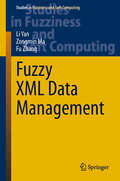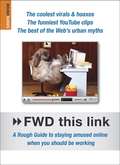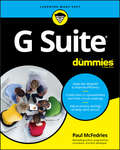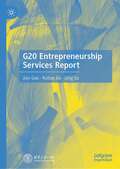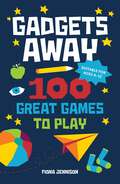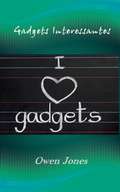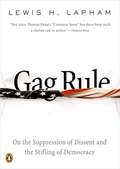- Table View
- List View
Fuzzy Machine Learning Algorithms for Remote Sensing Image Classification
by Anil Kumar A. Senthil Kumar Priyadarshi UpadhyayThis book covers the state-of-art image classification methods for discrimination of earth objects from remote sensing satellite data with an emphasis on fuzzy machine learning and deep learning algorithms. Both types of algorithms are described in such details that these can be implemented directly for thematic mapping of multiple-class or specific-class landcover from multispectral optical remote sensing data. These algorithms along with multi-date, multi-sensor remote sensing are capable to monitor specific stage (for e.g., phenology of growing crop) of a particular class also included. With these capabilities fuzzy machine learning algorithms have strong applications in areas like crop insurance, forest fire mapping, stubble burning, post disaster damage mapping etc. It also provides details about the temporal indices database using proposed Class Based Sensor Independent (CBSI) approach supported by practical examples. As well, this book addresses other related algorithms based on distance, kernel based as well as spatial information through Markov Random Field (MRF)/Local convolution methods to handle mixed pixels, non-linearity and noisy pixels. Further, this book covers about techniques for quantiative assessment of soft classified fraction outputs from soft classification and supported by in-house developed tool called sub-pixel multi-spectral image classifier (SMIC). It is aimed at graduate, postgraduate, research scholars and working professionals of different branches such as Geoinformation sciences, Geography, Electrical, Electronics and Computer Sciences etc., working in the fields of earth observation and satellite image processing. Learning algorithms discussed in this book may also be useful in other related fields, for example, in medical imaging. Overall, this book aims to: exclusive focus on using large range of fuzzy classification algorithms for remote sensing images; discuss ANN, CNN, RNN, and hybrid learning classifiers application on remote sensing images; describe sub-pixel multi-spectral image classifier tool (SMIC) to support discussed fuzzy and learning algorithms; explain how to assess soft classified outputs as fraction images using fuzzy error matrix (FERM) and its advance versions with FERM tool, Entropy, Correlation Coefficient, Root Mean Square Error and Receiver Operating Characteristic (ROC) methods and; combines explanation of the algorithms with case studies and practical applications.
Fuzzy Management: A Fuzzy Grassroots Ontology For Online Reputation Management (essentials)
by Andreas Meier Edy PortmannAndreas Meier und Edy Portmann verwenden in diesem essential über Fuzzy Management die unscharfe Logik zur Lösung betriebswirtschaftlicher Probleme in der digitalen Wirtschaft. Die unscharfe Logik erweitert die klassische Logik mit den beiden Werten „wahr“ und „falsch“ und führt zu differenzierteren Beurteilungen. Neben Portfolio Management, Performance Measurement, Service Level Engineering und Reputationsmanagement wird die Business Intelligence mit weichen Faktoren angereichert, um den Entscheidungsprozess zu verbessern.
Fuzzy Multi-criteria Decision-Making Using Neutrosophic Sets
by Cengiz Kahraman İrem OtayThis book offers a comprehensive guide to the use of neutrosophic sets in multiple criteria decision making problems. It shows how neutrosophic sets, which have been developed as an extension of fuzzy and paraconsistent logic, can help in dealing with certain types of uncertainty that classical methods could not cope with. The chapters, written by well-known researchers, report on cutting-edge methodologies they have been developing and testing on a variety of engineering problems. The book is unique in its kind as it reports for the first time and in a comprehensive manner on the joint use of neutrosophic sets together with existing decision making methods to solve multi-criteria decision-making problems, as well as other engineering problems that are complex, hard to model and/or include incomplete and vague data. By providing new ideas, suggestions and directions for the solution of complex problems in engineering and decision making, it represents an excellent guide for researchers, lecturers and postgraduate students pursuing research on neutrosophic decision making, and more in general in the area of industrial and management engineering.
Fuzzy Neural Intelligent Systems: Mathematical Foundation and the Applications in Engineering
by Hongxing Li C.L. Philip Chen Han-Pang HuangAlthough fuzzy systems and neural networks are central to the field of soft computing, most research work has focused on the development of the theories, algorithms, and designs of systems for specific applications. There has been little theoretical support for fuzzy neural systems, especially their mathematical foundations. Fuzzy Neural Intelligent Systems fills this gap. It develops a mathematical basis for fuzzy neural networks, offers a better way of combining fuzzy logic systems with neural networks, and explores some of their engineering applications. Dividing their focus into three main areas of interest, the authors give a systematic, comprehensive treatment of the relevant concepts and modern practical applications:Fundamental concepts and theories for fuzzy systems and neural networks.Foundation for fuzzy neural networks and important related topicsCase examples for neuro-fuzzy systems, fuzzy systems, neural network systems, and fuzzy-neural systemsSuitable for self-study, as a reference, and ideal as a textbook, Fuzzy Neural Intelligent Systems is accessible to students with a basic background in linear algebra and engineering mathematics. Mastering the material in this textbook will prepare students to better understand, design, and implement fuzzy neural systems, develop new applications, and further advance the field.
Fuzzy Petri Nets for Knowledge Representation, Acquisition and Reasoning
by Hua Shi Hu-Chen LiuThis book provides valuable knowledge, useful fuzzy Petri nets (FPN) models, and practical examples that can be considered by mangers in supporting knowledge management of organizations to increase and sustain their competitive advantages. In this book, the authors proposed various improved FPN models to enhance the modeling power and applicability of FPNs in knowledge representation and reasoning. This book is useful for practitioners and researchers working in the fields of knowledge management, operation management, information science, industrial engineering, and management science. It can also be used as a textbook for postgraduate and senior undergraduate students.
Fuzzy Quantitative Management: Principles, Methodologies and Applications (Fuzzy Management Methods)
by Shaopei Lin Guohua ZhaoThis book is devoted to fuzzy quantitative studies in managerial science, discussing the philosophical background and decision-making essentials. For reference, a series of practical examples illustrate broad areas of application that are important in project risk management problems, and in complicated mega projects. Using computers to simulate human intelligence with fuzzy approaches is the basis of “Fuzzy-AI model,” which offers an efficient tool capable of simulating human intelligence in order to perform digitized decision inference and quantitative information management.
Fuzzy Recurrence Plots and Networks with Applications in Biomedicine
by Tuan D. PhamThis book presents an original combination of three well-known methodological approaches for nonlinear data analysis: recurrence, networks, and fuzzy logic.After basic concepts of these three approaches are introduced, this book presents recently developed methods known as fuzzy recurrence plots and fuzzy recurrence networks. Computer programs written in MATLAB, which implement the basic algorithms, are included to facilitate the understanding of the developed ideas. Several applications of these techniques to biomedical problems, ranging from cancer and neurodegenerative disease to depression, are illustrated to show the potential of fuzzy recurrence methods. This book opens a new door to theorists in complex systems science as well as specialists in medicine, biology, engineering, physics, computer science, geosciences, and social economics to address issues in experimental nonlinear signal and data processing.
Fuzzy Relational Mathematical Programming: Linear, Nonlinear and Geometric Programming Models (Studies in Fuzziness and Soft Computing #389)
by Bing-Yuan Cao Ji-Hui Yang Xue-Gang Zhou Zeinab Kheiri Faezeh Zahmatkesh Xiao-Peng YangThis book summarizes years of research in the field of fuzzy relational programming, with a special emphasis on geometric models. It discusses the state-of-the-art in fuzzy relational geometric problems, together with key open issues that must be resolved to achieve a more efficient application of this method. Though chiefly based on research conducted by the authors, who were the first to introduce fuzzy geometric problems, it also covers important findings obtained in the field of linear and non-linear programming. Thanks to its balance of basic and advanced concepts, and its wealth of practical examples, the book offers a valuable guide for both newcomers and experienced researcher in the fields of soft computing and mathematical optimization.
Fuzzy Rule-Based Inference: Advances and Applications in Reasoning with Approximate Knowledge Interpolation
by Fangyi Li Qiang ShenThis book covers a comprehensive approach to the development and application of a suite of novel algorithms for practical approximate knowledge-based inference. It includes an introduction to the fundamental concepts of fuzzy sets, fuzzy logic, and fuzzy inference. Collectively, this book provides a systematic tutorial and self-contained reference to recent advances in the field of fuzzy rule-based inference. Approximate reasoning systems facilitate inference by utilizing fuzzy if-then production rules for decision-making under circumstances where knowledge is imprecisely characterized. Compositional rule of inference (CRI) and fuzzy rule interpolation (FRI) are two typical techniques used to implement such systems. The question of when to apply these potentially powerful reasoning techniques via automated computation procedures is often addressed by checking whether certain rules can match given observations. Both techniques have been widely investigated to enhance the performance of approximate reasoning. Increasingly more attention has been paid to the development of systems where rule antecedent attributes are associated with measures of their relative significance or weights. However, they are mostly implemented in isolation within their respective areas, making it difficult to achieve accurate reasoning when both techniques are required simultaneously. This book first addresses the issue of assigning equal significance to all antecedent attributes in the rules when deriving the consequents. It presents a suite of weighted algorithms for both CRI and FRI fuzzy inference mechanisms. This includes an innovative reverse engineering process that can derive attribute weightings from given rules, increasing the automation level of the resulting systems. An integrated fuzzy reasoning approach is then developed from these two sets of weighted improvements, showcasing more effective and efficient techniques for approximate reasoning. Additionally, the book provides an overarching application to interpretable medical risk analysis, thanks to the semantics-rich fuzzy rules with attribute values represented in linguistic terms. Moreover, it illustrates successful solutions to benchmark problems in the relevant literature, demonstrating the practicality of the systematic approach to weighted approximate reasoning.
Fuzzy Sets Methods in Image Processing and Understanding: Medical Imaging Applications
by Isabelle Bloch Anca RalescuThis book provides a thorough overview of recent methods using higher level information (object or scene level) for advanced tasks such as image understanding along with their applications to medical images. Advanced methods for fuzzy image processing and understanding are presented, including fuzzy spatial objects, geometry and topology, mathematical morphology, machine learning, verbal descriptions of image content, fusion, spatial relations, and structural representations. For each methodological aspect covered, illustrations from the medical imaging domain are provided. This is an ideal book for graduate students and researchers in the field of medical image processing.
Fuzzy Sets Theory Preliminary: Can A Washing Machine Think?
by Bing-Yuan Cao Hao-Ran Lin Yun-Zhang LiaoThis basic book has been used at the middle schools in Shanghai, China for more than 10 years. The book presents carefully-selected contents in order to achieve the roles of enlightenment and popularization. It mainly includes: Chapter 1: Human Brains, Computers and Fuzzy Mathematics; Chapter 2: Matrix, Fuzzy Relations and Fuzzy Matrix; Chapter 3: Fuzzy Control; Chapter 4: Fuzzy Statistics and Fuzzy Probability and Chapter 5: Fuzzy Linear Programming. It includes at the end of each chapter concise, interesting and profound reading and thinking materials, and a certain amount of exercises so as to make it an informative and interesting textbook. This book can be used not only as a textbook in senior middle schools, and in vocational colleges, but also as a primer for individually learning fuzzy mathematics.
Fuzzy Solution Concepts for Non-cooperative Games: Interval, Fuzzy and Intuitionistic Fuzzy Payoffs (Studies in Fuzziness and Soft Computing #383)
by Tina Verma Amit KumarThis book proposes novel methods for solving different types of non-cooperative games with interval/fuzzy/intuitionistic fuzzy payoffs. It starts by discussing several existing methods and shows that some mathematically incorrect assumptions have been considered in all these methods. It then proposes solutions to adapt those methods and validate the new proposed methods, such as Gaurika method Ambika-I-IV, Mehar method and others, by using them for solving existing numerical problems. The book offers a comprehensive guide on non-cooperative games with fuzzy payoffs to both students and researchers. It provides them with the all the necessary tools to understand the methods and the theory behind them.
Fuzzy Spatiotemporal XML Data Management (Studies in Computational Intelligence #1183)
by Luyi Bai Lin ZhuSpatiotemporal data is not always precise, and fuzziness in spatiotemporal data is usually accepted because of the way the world is measured and represented. Although eXtensible Markup Language (XML) recommended by the World Wide Web Consortium (W3C) has become the de-facto standard for data representation and exchange on the Web, an edited collection of fuzzy spatiotemporal XML data management studies is still scarce. This book studies fuzzy XML approaches for spatiotemporal data management that can greatly enhance the utilization of this sort of data for spatiotemporal applications. The book is anticipated to serve as a valuable resource in this field and is expected to attract considerable interest from researchers and developers engaged in the applications within the domain of spatiotemporal data management.
Fuzzy Stochastic Optimization
by Shuming Wang Junzo WatadaCovering in detail both theoretical and practical perspectives, this book is a self-contained and systematic depiction of current fuzzy stochastic optimization that deploys the fuzzy random variable as a core mathematical tool to model the integrated fuzzy random uncertainty. It proceeds in an orderly fashion from the requisite theoretical aspects of the fuzzy random variable to fuzzy stochastic optimization models and their real-life case studies. The volume reflects the fact that randomness and fuzziness (or vagueness) are two major sources of uncertainty in the real world, with significant implications in a number of settings. In industrial engineering, management and economics, the chances are high that decision makers will be confronted with information that is simultaneously probabilistically uncertain and fuzzily imprecise, and optimization in the form of a decision must be made in an environment that is doubly uncertain, characterized by a co-occurrence of randomness and fuzziness. This book begins by outlining the history and development of the fuzzy random variable before detailing numerous optimization models and applications that include the design of system controls for a dam.
Fuzzy System Identification and Adaptive Control (Communications and Control Engineering)
by Ruiyun Qi Gang Tao Bin JiangThis book provides readers with a systematic and unified framework for identification and adaptive control of Takagi–Sugeno (T–S) fuzzy systems. Its design techniques help readers applying these powerful tools to solve challenging nonlinear control problems. The book embodies a systematic study of fuzzy system identification and control problems, using T–S fuzzy system tools for both function approximation and feedback control of nonlinear systems. Alongside this framework, the book also: introduces basic concepts of fuzzy sets, logic and inference system; discusses important properties of T–S fuzzy systems; develops offline and online identification algorithms for T–S fuzzy systems; investigates the various controller structures and corresponding design conditions for adaptive control of continuous-time T–S fuzzy systems; develops adaptive control algorithms for discrete-time input–output form T–S fuzzy systems with much relaxed design conditions, and discrete-time state-space T–S fuzzy systems; and designs stable parameter-adaptation algorithms for both linearly and nonlinearly parameterized T–S fuzzy systems. The authors address adaptive fault compensation problems for T–S fuzzy systems subject to actuator faults. They cover a broad spectrum of related technical topics and to develop a substantial set of adaptive nonlinear system control tools. Fuzzy System Identification and Adaptive Control helps engineers in the mechanical, electrical and aerospace fields, to solve complex control design problems. The book can be used as a reference for researchers and academics in nonlinear, intelligent, adaptive and fault-tolerant control.
Fuzzy Techniques: Proceedings of the 2019 Joint World Congress of the International Fuzzy Systems Association and the Annual Conference of the North American Fuzzy Information Processing Society IFSA/NAFIPS'2019 (Lafayette, Louisiana, USA, June 18–21, 2019) (Advances in Intelligent Systems and Computing #1000)
by Ralph Baker Kearfott Ildar Batyrshin Marek Reformat Martine Ceberio Vladik KreinovichThis book describes the latest findings related to fuzzy techniques, discussing applications in control, economics, education, humor studies, industrial engineering, linguistics, management, marketing, medicine and public health, military engineering, robotics, ship design, sports, transportation, and many other areas. It also presents recent fuzzy-related algorithms and theoretical results that can be used in other application areas. Featuring selected papers from the Joint World Congress of the International Fuzzy Systems Association (IFSA) and the Annual Conference of the North American Fuzzy Information Processing Society (NAFIPS) IFSA-NAFIPS’2019, held in Lafayette, Louisiana, USA, on June 18–21, 2019, the book is of interest to practitioners wanting to use fuzzy techniques to process imprecise expert knowledge. It is also a valuable resource for researchers wishing to extend the ideas from these papers to new application areas, for graduate students and for anyone else interested in problems involving fuzziness and uncertainty.
Fuzzy Technology
by Janusz Kacprzyk Mario Fedrizzi Mikael CollanThisbook provides readers with a timely and comprehensive yet concise view on the field of fuzzy logic and its real-world applications. The chapters, writtenby authoritative scholars in the field, report on promising new models for dataanalysis, decision making, and systems modeling, with a special emphasis on theirapplications in management science. The book is a token of appreciation from the fuzzy researchcommunity to Professor Christer Carlsson for his long time research and organizationalcommitment, which have among other things resulted in the foundation and success of theInstitute for Advanced Management Systems Research (IAMSR) at Åbo Akademi University, in Åbo(Turku), Finland. The book serves as timely guide for the fuzzy logic andoperations research communities alike.
Fuzzy XML Data Management
by Li Yan Zongmin Ma Fu ZhangThis book presents an exhaustive and timely review of key research work on fuzzy XML data management, and provides readers with a comprehensive resource on the state-of-the art tools and theories in this fast growing area. Topics covered in the book include: representation of fuzzy XML, query of fuzzy XML, fuzzy database models, extraction of fuzzy XML from fuzzy database models, reengineering of fuzzy XML into fuzzy database models, and reasoning of fuzzy XML. The book is intended as a reference guide for researchers, practitioners and graduate students working and/or studying in the field of Web Intelligence, as well as for data and knowledge engineering professionals seeking new approaches to replace traditional methods, which may be unnecessarily complex or even unproductive.
FWD This Link: A Rough Guide to Staying Amused Online When You Should Be Working
by Peter Buckey Rhodri MarsdenFrom skate-boarding dogs to Arnold Schwarzenegger photoshopped into a swimsuit and sat on George Bush's lap, FWD This Link brings together the biggest distractions of the past decade into an addictive user-friendly Rough Guide. Rhodri Marsden, Technology columnist for the Independent and guru on the webs weirdest, shares the coolest virals and hoaxes and the funniest YouTube clips. Discover the unsuspecting internet stars, and the reason why we loved them from the Star Wars Kid to the Numa Numa guy. The guide is packed with the webs most entertaining wildlife including fainting goats and frisky donkeys. Let's not forget the power of the email and those living to regret clicking the "send" button, only for their heart-felt love letters to be splashed across the press the next morning. Those wonderful websites that have you coming back again and again, brow-furrowing collections, online museums and shopping sites that defy belief -- they're all here to keep you amused online when you should be working. Warning: This book will not help you clear your Inbox.
G Suite For Dummies
by Paul McFedriesGet fast answers to your G Suite questions with this friendly resource G Suite For Dummies is the fun guide to the productivity suite that’s quickly winning over professional and personal users. This book shares the steps on how to collaborate in the cloud, create documents and spreadsheets, build presentations, and connect with chat or video. Written in the easy-to-follow For Dummies style, G Suite For Dummies covers the essential components of Google’s popular software, including: Google Docs for word processing Gmail for email Google Calendar for scheduling and day planning Google Sheets for spreadsheet functionality Google Drive for data storage Google Hangouts and Google Meet for videoconferencing and calling capability The book helps navigate the G Suite payment plans and subscription options as well as settings that ensure your own privacy and security while operating in the cloud. Perfect for anyone hoping to get things done with this tool, G Suite For Dummies belongs on the bookshelf of every G Suite user who needs help from time to time.
G20 Entrepreneurship Services Report
by Jian Gao Ruitao Jia Qing SuThis book focuses on the progress of G20 members on entrepreneurship services since the G20 Entrepreneurship Action Plan was issued at the G20 Hangzhou Summit in China. The authors analyse the similarities and differences of policy measures taken by G20 members from five aspects of entrepreneurship services: government services, fiscal and financial supports, entrepreneur services, entrepreneurship education, and fair competition for SMEs. The book aims to bridge academic research with the multilevel and diverse practice in entrepreneurial activities and explores how national policies and conditions can promote entrepreneurship among G20 members. This book will inspire the policy- makers, stakeholders in the entrepreneurship ecosystems and scholars on entrepreneurship research as well, on how to promote the entrepreneurship as an effective way to stimulate employment growth, boost innovation development, and realize economic recovery in the post- COVID-19 era.
Gadget Interessanti (Come fare... #28)
by Owen JonesGli articoli presenti in questo ebook sono suggerimenti e consigli su gadget, strumenti interessanti anche per gli adulti e argomenti simili. Tuttavia, il libro dovrebbe essere considerato nella sua totalità. Il testo è composto su diversi livelli: spero che troverai le sue informazioni utili, e inoltre, comprandolo, potrai anche usarne i contenuti nelle tue pubblicazioni.
Gadgets Away: 100 Games To Play With The Family
by Fiona JennisonTechnology has become the too-easy way to entertain ourselves and our children. This easy-to-use, imaginative book has everything. There’s plenty of fun here to keep your family laughing: Sporty games and playground classics Activities for indoors, gardens, parks and beaches Memory and travel games, brain teasers and magic tricks
Gadgets Interessantes (Como fazer... #28)
by Owen JonesGadgets Interessantes Olá e obrigado por comprar este ebook chamado "Gadgets Interessantes". Espero que você ache as informações prestativas, úteis e lucrativas. As informações contidas neste e-book sobre vários tipos de gadgets, brinquedos para adultos e assuntos relacionados estão organizadas em 16 capítulos com cerca de 500 a 600 palavras cada. Espero que seja do interesse de quem gosta de tecnologia moderna e de gadgets. Como um bónus adicional, concedo-lhe a permissão para usar o conteúdo no seu próprio site ou nos seus próprios blogs e newsleters, embora seja melhor se antes você os reescrever com as suas próprias palavras. Você também pode dividir o livro e revender os artigos. De facto, o único direito que você não tem é revender ou doar o livro como ele lhe foi entregue. Se você tiver algum comentário, deixe-o na empresa onde você comprou este livro. Você também encontrará mais livros como este por lá. Agradecemos novamente por adquirir este ebook, Saudações, Owen Jones
Gag Rule: On the Suppression of Dissent and the Stifling of Democracy
by Lewis LaphamLapham issues a call to action in defense of one of our most important liberties--the right to raise our voices against the powers that be and have those voices heard.
